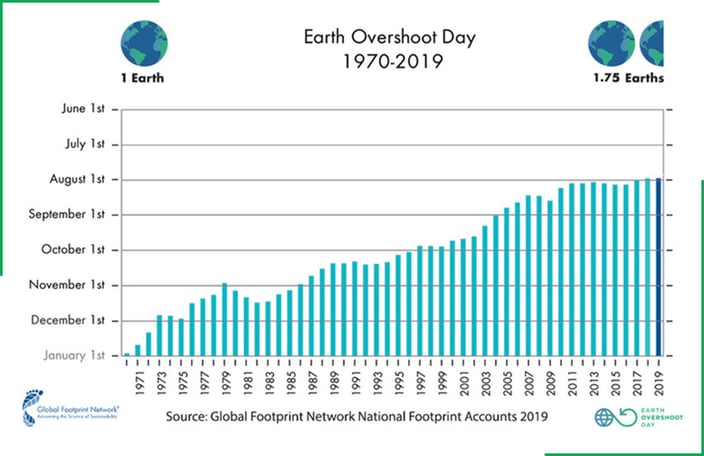Listen here:
Earth’s natural resources including clean air, fresh water, and all that we associate with “nature” are being consumed by mankind 1.75 times faster than the planet’s ecosystems can regenerate. Did you know that as of July 29, we have used up our “resource budget” that we were allowed for the entire year? [A quick reminder: it’s only the beginning of August today].
July 29 this year marked what is known as “Earth Overshoot Day” based on calculations by Global Footprint Network, an international research organization that is reconditioning how the world measures and manages the utilization of natural resources. The date for every year is arrived at by calculating the amount of resources such as water, land, fish, and forests all humanity uses, along with how much carbon dioxide is let out into the atmosphere.
Earth Overshoot Day marks the date when humanity’s demand for ecological resources (fish and forests, for instance) and services in a given year exceeds what Earth can regenerate in that year.
The initiative, first conceived in 2006 by Andrew Simms, has been calculating the Earth Overshoot Day since 1986, the date has moved up by two months in the last 2 decades, according to a study by Global Footprint Network.

Cities, energy, food, planet, and population are considered the five major areas that impact the sustainability of Earth and its resources. Among them, global food systems contribute up to 29% of global greenhouse gases. The rising human population will continue to demand more food, feed, fiber, and fuel every year, but these impact numbers can be lowered significantly by bringing about small changes in how we produce, distribute and consume food the world over.
Farm activities that are well-planned and critically managed for better efficiency at every point of the production cycle could shorten the gap between the crop’s current and potential yields. Climate-smart farming systems that include irrigation systems optimized for the region’s climatic and water stress conditions, and the prudent use of fertilizers and other agri-inputs can ensure sustainable farming in the long run.
One of the targets of the UN Sustainable Development Goal #12 Sustainable Consumption and Production is to halve per capita global food waste at the retail and consumer levels and reduce food losses along production and supply chains, including post-harvest losses, by 2030.
If we cut food waste by half worldwide, we would move Overshoot Day by 10 days. To be sustainable, development ultimately must also fit within our planet’s resource budget.
#MoveTheDate of Earth Overshoot Day.
One solution to all of these problems may not be possible, but digitization and adoption of advanced technologies and automation in agriculture are undoubtedly bringing about a revolution in food production and distribution processes over the last few years. Numerous agritech solutions today present innovative answers to challenges posed by conventional agricultural practices that have been degrading the environment. Precision agriculture solutions are facilitating an increase in yield by optimizing resource utilization, providing accurate farm advisories, and delivering timely alerts on crop risks such as pests, diseases, and weather irregularities. Furthermore, agritech solutions such as CropIn’s are playing an indispensable role in reducing global food wastage, which is about one-third of the total food produced today. Agri-technology is also fashioning a supply chain that is now more organized and highly efficient and is establishing better collaboration between the stakeholders in the agri-ecosystem.
Every little action counts. If each individual and every entity take the right steps toward moving Earth Overshoot Day back five days each year, we could ensure by the year 2050 a balance between what we use and what the Earth can regenerate in that year.
Further Reading
How does agriculture make big gains with the infusion of technology in the sector? How can agri-tech solve some of the world’s major food-related challenges?
How does agriculture make big gains with the infusion of technology in the sector? In what ways can agri-tech solve some of the world’s major food-related challenges?









